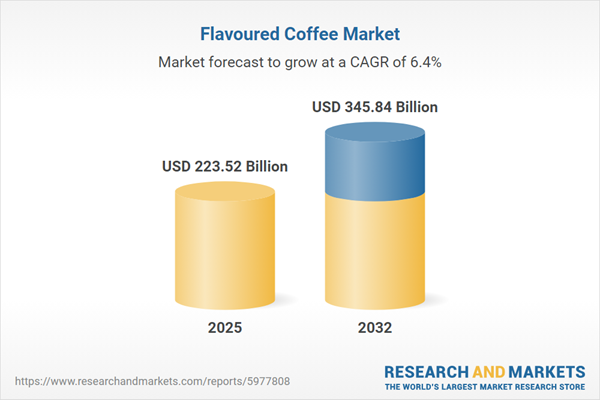Speak directly to the analyst to clarify any post sales queries you may have.
The global flavoured coffee market is experiencing significant transformation as procurement leaders respond to evolving sourcing standards, sustainability targets, and region-specific market dynamics. Senior executives are now challenged to develop agile supply strategies that address rapidly changing consumer demands and keep pace with digital advancements.
Market Snapshot: Dynamics of the Flavoured Coffee Market
The flavoured coffee market holds a unique position within the beverage industry, propelled by a cycle of product innovation and consistent growth. Distinctive flavour profiles, advanced extraction methods, and rising expectations for quality and variety help suppliers differentiate their offerings and meet the heightened standards of institutional buyers. The steady integration of digital procurement systems enhances visibility and operational resilience, streamlining commercial transactions across both retail and e-commerce platforms. Established brands and emerging entrants are broadening their portfolios, which intensifies competition and enriches distribution capabilities. Companies that closely monitor regional shifts and regulatory developments gain an adaptive edge, aligning products with complex market needs as business requirements diversify and rivalry intensifies.
Scope & Segmentation: Actionable Insights for B2B Leaders
This report delivers in-depth segmentation and operational intelligence tailored for senior leaders managing procurement, innovation, and global expansion within the flavoured coffee market. Every key driver is analyzed to support informed, business-centric decisions:
- Distribution Channels: Digital and e-commerce models empower B2B buyers to accelerate order cycles, simplify procurement, and fulfill high-frequency resupply requirements.
- Product Formats: Ground, instant, and single-serve forms are designed for diverse commercial environments such as hotels, corporate campuses, and foodservice operations, adapting to varied volume needs.
- Bean Types: Varieties including Arabica, robusta, and specialty blends enable brands to tailor offerings, satisfying the taste profiles and procurement policies of institutional clients.
- Roast Levels: Analysis of light, medium, and dark preferences provides actionable data for product positioning by geography and customer segment.
- Flavor Types: Choices such as caramel, chocolate, hazelnut, mocha, and vanilla highlight a move toward premium, sustainable, and differentiated portfolios.
- Regions: Coverage spans the Americas, Europe, Middle East, Africa, and Asia-Pacific, ensuring tailored strategies for local compliance, sourcing, and market access.
- Key Companies: Market insights include benchmarking and partnership perspectives on leading players like Nestlé S.A., JDE Peet’s N.V., Keurig Dr Pepper Inc., Starbucks Corporation, The J. M. Smucker Company, The Kraft Heinz Company, Luigi Lavazza S.p.A., Tchibo GmbH, Strauss Group Ltd., and Illycaffè S.p.A.
Key Takeaways: Strategic Imperatives for Market Leaders
- Accelerate innovation and extend flavour choices to capture commercial accounts and build repeat procurement partnerships across institutional segments.
- Maintain supply continuity as organizations expand use of subscription models, requiring dependable supply chain performance and inventory planning.
- Advance sustainability initiatives by integrating responsible sourcing and eco-friendly packaging with procurement policies, aligning with corporate mandates and stakeholder expectations.
- Balance central strategies with regional adaptation to ensure regulatory compliance and strong positioning within diverse and evolving markets.
- Explore business growth through alliances, acquisitions, or collaborative ventures to enter new segments, achieve product diversification, and enhance distribution networks.
Tariff Impact: United States Supply Chain Evolution
Updates to United States import tariffs have introduced additional expenses for flavoured coffee producers and suppliers. In response, companies are amending contracts, modifying procurement routines, and refining logistics plans to sustain stable supply chains during regulatory changes.
Methodology & Data Sources
Research data was collected through direct interviews with industry experts, feedback from institutional buyers, and insights from flavour technologists. Supplementary intelligence is provided by trade documentation, buyer surveys, and retail analytics, with recommendations validated by sector specialists.
Why This Report Matters
- Supplies frameworks for product innovation, robust sourcing, and opportunity identification in the flavoured coffee sector.
- Presents benchmarking tools and regulatory guidance to inform executive action within an evolving competitive landscape.
- Enables segmentation and resource allocation to drive evidence-based business outcomes and uncover new value opportunities.
Conclusion
This report delivers senior executives pragmatic insights to navigate the evolving flavoured coffee market, enhance procurement efficiency, and make informed leadership decisions throughout changing market cycles.
Additional Product Information:
- Purchase of this report includes 1 year online access with quarterly updates.
- This report can be updated on request. Please contact our Customer Experience team using the Ask a Question widget on our website.
Table of Contents
3. Executive Summary
4. Market Overview
7. Cumulative Impact of Artificial Intelligence 2025
Companies Mentioned
The companies profiled in this Flavoured Coffee market report include:- Nestlé S.A.
- JDE Peet’s N.V.
- Keurig Dr Pepper Inc.
- Starbucks Corporation
- The J. M. Smucker Company
- The Kraft Heinz Company
- Luigi Lavazza S.p.A.
- Tchibo GmbH
- Strauss Group Ltd.
- Illycaffè S.p.A.
Table Information
| Report Attribute | Details |
|---|---|
| No. of Pages | 181 |
| Published | October 2025 |
| Forecast Period | 2025 - 2032 |
| Estimated Market Value ( USD | $ 223.52 Billion |
| Forecasted Market Value ( USD | $ 345.84 Billion |
| Compound Annual Growth Rate | 6.4% |
| Regions Covered | Global |
| No. of Companies Mentioned | 11 |









